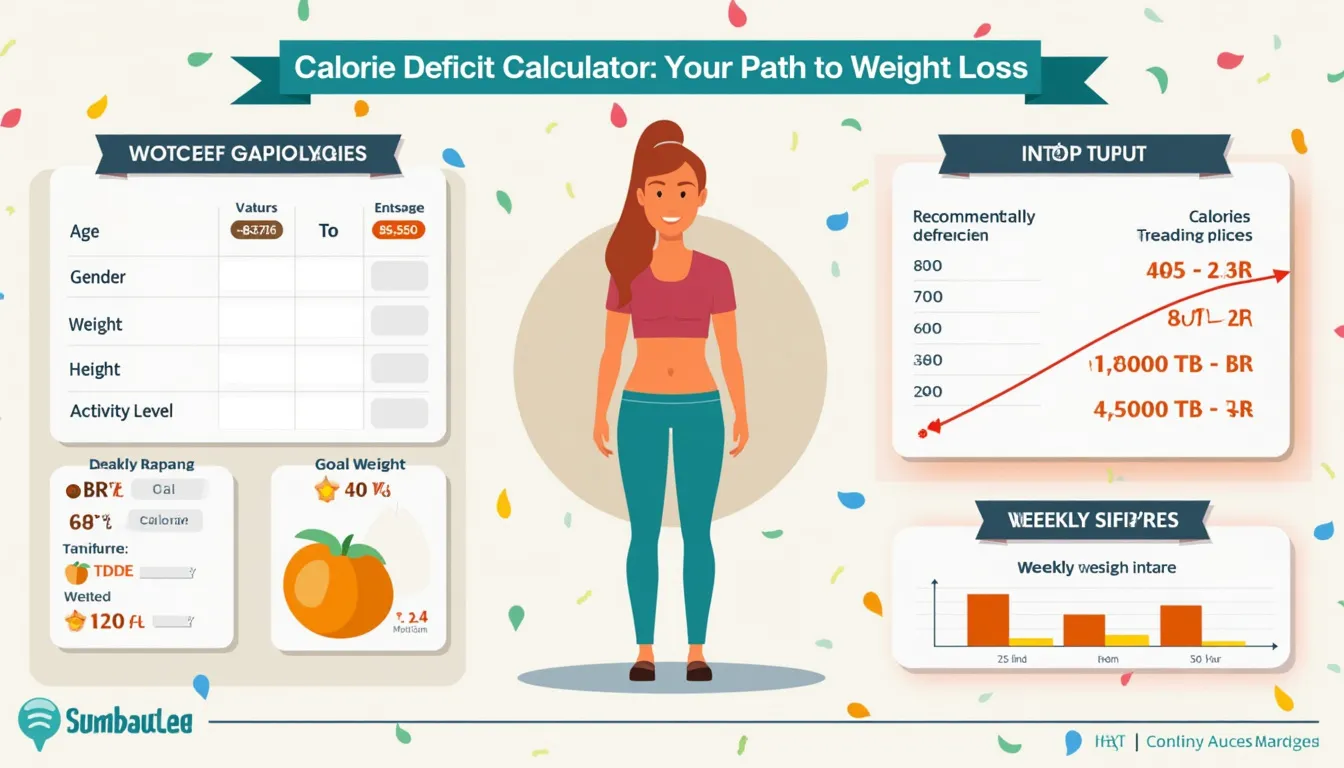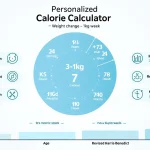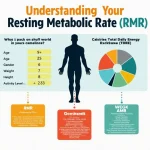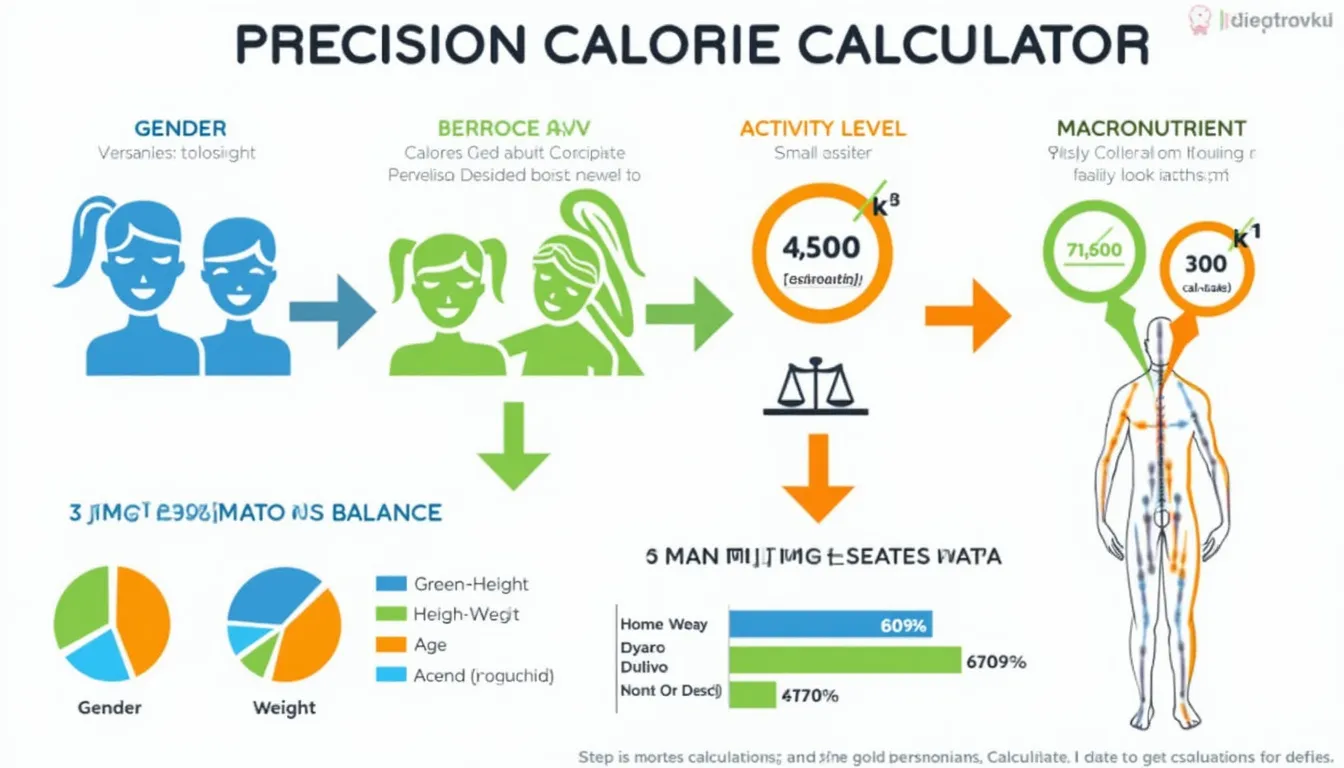Calorie Deficit Calculator
Is this tool helpful?
How to Use the Calorie Deficit Calculator Effectively
To make the most of our Calorie Deficit Calculator, follow these simple steps:
- Age: Enter your current age in years. For example, 35.
- Gender: Select your biological gender (male or female) from the dropdown menu.
- Weight: Input your current weight in kilograms. For instance, 80 kg.
- Height: Enter your height in centimeters. For example, 175 cm.
- Activity Level: Choose your activity level from the dropdown menu:
- Sedentary (little to no exercise)
- Lightly Active (light exercise 1-3 days/week)
- Moderately Active (moderate exercise 3-5 days/week)
- Very Active (hard exercise 6-7 days/week)
- Extra Active (very hard exercise & physical job)
- Goal Weight: Enter your target weight in kilograms. For example, 70 kg.
- Timeframe: Specify the number of weeks you aim to achieve your goal weight. For instance, 12 weeks.
- Click the “Calculate” button to generate your personalized results.
After submitting your information, the calculator will display your results, including your Basal Metabolic Rate (BMR), Total Daily Energy Expenditure (TDEE), daily calorie deficit, recommended daily calorie intake, and estimated weekly weight loss.
Understanding Calorie Deficit: Your Path to Effective Weight Loss
A calorie deficit occurs when you consume fewer calories than your body burns. This concept is the cornerstone of weight loss, as it forces your body to use stored fat for energy, resulting in weight reduction. Our Calorie Deficit Calculator is designed to help you determine the optimal calorie deficit for achieving your weight loss goals safely and effectively.
The Science Behind Calorie Deficit
To understand how a calorie deficit leads to weight loss, it’s essential to grasp the basic principles of energy balance:
- Energy In: The calories you consume through food and drinks.
- Energy Out: The calories your body burns through basic functions (BMR) and physical activity (TDEE).
When Energy In is less than Energy Out, you create a calorie deficit. The mathematical representation of this concept is:
$$\text{Calorie Deficit} = \text{Energy Out} – \text{Energy In}$$For weight loss to occur, you need to maintain a consistent calorie deficit over time. The general rule is that a deficit of 3,500 calories leads to approximately 1 pound (0.45 kg) of fat loss.
Key Components of the Calorie Deficit Calculator
1. Basal Metabolic Rate (BMR)
BMR represents the number of calories your body burns at rest to maintain basic life functions. We calculate BMR using the Mifflin-St Jeor equation:
For men:
$$\text{BMR} = 10 \times \text{weight(kg)} + 6.25 \times \text{height(cm)} – 5 \times \text{age(years)} + 5$$For women:
$$\text{BMR} = 10 \times \text{weight(kg)} + 6.25 \times \text{height(cm)} – 5 \times \text{age(years)} – 161$$2. Total Daily Energy Expenditure (TDEE)
TDEE accounts for your BMR plus the calories burned through daily activities and exercise. It’s calculated by multiplying your BMR by an activity factor:
$$\text{TDEE} = \text{BMR} \times \text{Activity Factor}$$Activity factors range from 1.2 for sedentary individuals to 1.9 for extra active individuals.
3. Calorie Deficit Calculation
The calculator determines your daily calorie deficit based on your weight loss goal and timeframe:
$$\text{Daily Calorie Deficit} = \frac{(\text{Current Weight} – \text{Goal Weight}) \times 7700}{\text{Timeframe (days)}}$$This formula uses the approximation that 1 kg of body fat contains about 7,700 calories.
Benefits of Using the Calorie Deficit Calculator
1. Personalized Weight Loss Plan
By inputting your specific details, you receive a tailored calorie deficit plan that aligns with your unique body composition and weight loss goals. This personalization increases the likelihood of success compared to generic diet plans.
2. Safe and Sustainable Weight Loss
The calculator ensures that your calorie deficit is within a safe range, typically aiming for a weight loss of 0.5 to 1 kg per week. This approach promotes sustainable weight loss, reducing the risk of rapid weight loss that can lead to muscle loss and metabolic slowdown.
3. Realistic Goal Setting
By providing both your goal weight and desired timeframe, the calculator helps you set realistic expectations. It will show you if your goals are achievable within the given time or if you need to adjust your expectations for healthier, long-term results.
4. Increased Awareness of Energy Balance
Using the calculator regularly increases your understanding of how your body’s energy needs change as you lose weight. This awareness can help you make informed decisions about your diet and exercise habits.
5. Motivation and Progress Tracking
Having a clear, numbers-based goal can be highly motivating. The calculator allows you to track your progress and adjust your calorie intake as needed, helping you stay on course towards your weight loss goals.
Addressing User Needs: How the Calorie Deficit Calculator Solves Common Weight Loss Challenges
Challenge 1: Determining the Right Calorie Intake
Many people struggle to determine how many calories they should consume for weight loss. Our calculator solves this by providing a precise daily calorie target based on your current stats and goals.
Example Calculation:
Let’s consider a 30-year-old woman, 165 cm tall, weighing 70 kg, with a moderately active lifestyle, aiming to reach 65 kg in 12 weeks.
- BMR = 10 × 70 + 6.25 × 165 – 5 × 30 – 161 = 1,441.25 kcal/day
- TDEE = 1,441.25 × 1.55 (moderately active) = 2,233.94 kcal/day
- Total weight loss goal = 70 kg – 65 kg = 5 kg
- Daily calorie deficit = (5 kg × 7,700 kcal/kg) / (12 weeks × 7 days) = 458.33 kcal/day
- Recommended daily calorie intake = 2,233.94 – 458.33 = 1,775.61 kcal/day
This calculation provides a clear, personalized target for daily calorie consumption.
Challenge 2: Balancing Weight Loss Rate and Sustainability
The calculator helps users find the sweet spot between losing weight too slowly (which can be demotivating) and too quickly (which can be unhealthy and unsustainable).
Example Scenario:
If our previous example user changed her goal to lose 5 kg in 6 weeks instead of 12:
- New daily calorie deficit = (5 kg × 7,700 kcal/kg) / (6 weeks × 7 days) = 916.67 kcal/day
- New recommended daily calorie intake = 2,233.94 – 916.67 = 1,317.27 kcal/day
The calculator would flag this as potentially too aggressive, as it’s below the recommended minimum of 1,200 kcal/day for women, encouraging a more sustainable approach.
Challenge 3: Adapting to Changing Energy Needs
As you lose weight, your body’s calorie needs decrease. The calculator allows for easy recalculation as your weight changes, ensuring continued progress.
Example Progression:
After 6 weeks, our example user has lost 2.5 kg. Recalculating with her new weight of 67.5 kg:
- New BMR = 1,421.25 kcal/day
- New TDEE = 2,202.94 kcal/day
- Remaining weight loss goal = 2.5 kg
- New daily calorie deficit = (2.5 kg × 7,700 kcal/kg) / (6 weeks × 7 days) = 458.33 kcal/day
- Updated recommended daily calorie intake = 2,202.94 – 458.33 = 1,744.61 kcal/day
This adjustment ensures the user continues to lose weight at a steady rate despite her changing body composition.
Practical Applications: Real-World Uses of the Calorie Deficit Calculator
1. Preparing for a Special Event
Many people use the calculator to prepare for weddings, reunions, or vacations. For instance, a bride-to-be might use it to lose 5 kg in the 3 months leading up to her wedding, ensuring she feels confident on her big day.
2. Kickstarting a Fitness Journey
Individuals embarking on a fitness journey often use the calculator to set initial goals. A sedentary office worker deciding to get fit might use it to plan a 10 kg weight loss over 6 months, combining the calorie deficit with a new exercise routine.
3. Breaking Through Weight Loss Plateaus
Experienced dieters often hit plateaus. By recalculating their calorie needs, they can adjust their intake to resume progress. For example, someone who’s lost 20 kg but has stalled for a month can use the calculator to determine a new, lower calorie target.
4. Sports Performance Optimization
Athletes in weight-class sports like wrestling or boxing use the calculator to plan their weight cut before competitions. A boxer might use it to drop 3 kg in the 8 weeks leading up to a fight, ensuring they make weight while maintaining strength.
5. Post-Pregnancy Weight Loss
New mothers often use the calculator to lose pregnancy weight safely. For instance, a woman might aim to lose 15 kg over 6 months post-partum, using the calculator to ensure she’s eating enough to support breastfeeding while still creating a modest calorie deficit.
Frequently Asked Questions (FAQ)
Q1: How accurate is the Calorie Deficit Calculator?
A1: The calculator provides a scientifically-based estimate using well-established formulas. However, individual metabolisms can vary, so it’s best to use the results as a starting point and adjust based on your actual weight loss progress.
Q2: Can I use this calculator if I’m trying to gain weight?
A2: While the calculator is designed for weight loss, you can use it to determine your maintenance calories (TDEE). To gain weight, you’d need to consume more than this amount.
Q3: Should I eat back the calories I burn through exercise?
A3: The activity level you select in the calculator already accounts for your exercise. Eating back additional calories could slow your weight loss progress.
Q4: What’s the minimum number of calories I should eat?
A4: Generally, it’s not recommended to go below 1,200 calories per day for women and 1,500 for men. If the calculator suggests a lower intake, consult with a healthcare professional.
Q5: How often should I recalculate my calorie needs?
A5: It’s a good idea to recalculate every 5-10 pounds (2.3-4.5 kg) of weight loss, or if you significantly change your activity level.
Q6: Can I use this calculator if I have a medical condition?
A6: While the calculator is based on general principles, individuals with medical conditions should consult their healthcare provider before starting any weight loss program.
Q7: What if I’m not losing weight at the rate the calculator predicts?
A7: Many factors can affect weight loss. If you’re not seeing expected results after a few weeks, double-check your calorie counting, ensure you’re measuring portions accurately, and consider factors like stress or sleep that might impact weight loss.
Q8: Is it better to create a calorie deficit through diet or exercise?
A8: A combination of both is usually most effective and sustainable. The calculator accounts for your activity level, so focus on sticking to the recommended calorie intake while maintaining your chosen activity level.
Q9: How does muscle mass affect the calculator’s accuracy?
A9: The calculator doesn’t directly account for muscle mass. Very muscular individuals might find their actual calorie needs are higher than calculated. In such cases, it’s best to start with the calculator’s recommendation and adjust based on results.
Q10: Can I use this calculator for intermittent fasting?
A10: Yes, the total daily calorie recommendation remains relevant regardless of eating schedule. However, you may need to adjust how you distribute these calories within your eating window.
By leveraging the power of our Calorie Deficit Calculator and understanding the science behind weight loss, you’re well-equipped to embark on a successful, sustainable weight loss journey. Remember, while the calculator provides valuable guidance, it’s essential to listen to your body, stay consistent, and celebrate your progress along the way. With patience and persistence, you’ll be well on your way to achieving your weight loss goals and improving your overall health and well-being.
Important Disclaimer
The calculations, results, and content provided by our tools are not guaranteed to be accurate, complete, or reliable. Users are responsible for verifying and interpreting the results. Our content and tools may contain errors, biases, or inconsistencies. We reserve the right to save inputs and outputs from our tools for the purposes of error debugging, bias identification, and performance improvement. External companies providing AI models used in our tools may also save and process data in accordance with their own policies. By using our tools, you consent to this data collection and processing. We reserve the right to limit the usage of our tools based on current usability factors. By using our tools, you acknowledge that you have read, understood, and agreed to this disclaimer. You accept the inherent risks and limitations associated with the use of our tools and services.







